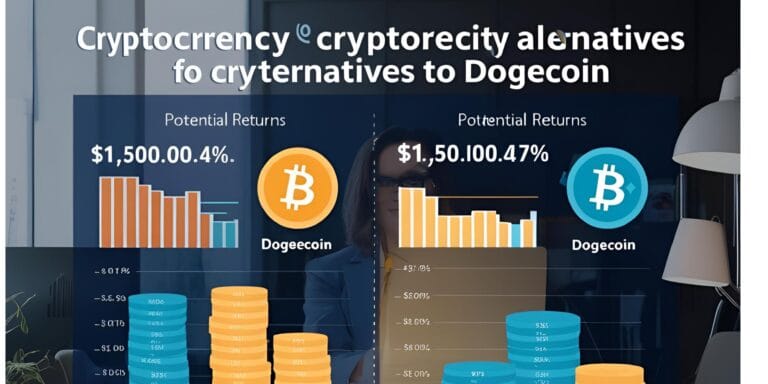Will Cryptocurrency Market Recover in 2025? Top Blockchain Trends to Watch
Market Recovery: The crypto market’s mood swings are nothing less than a blockbuster movie—one day Bitcoin soars sky-high, and the next, there’s a slight dip. In 2024, the total crypto market cap reached $3.91 trillion, almost matching its record high from 2021. However, in the first quarter of 2025, volatility was observed due to US trade tariffs and macroeconomic factors. So, will the market recover in 2025? Let’s break it down.

Crypto Market Recovery in 2025: Trends and Insights
The crypto market in 2024 was a thrilling ride, with Bitcoin soaring to $108,786 and the total market cap hitting $3.91 trillion, nearly matching its 2021 peak. However, 2025 started with volatility due to US trade tariffs and macroeconomic factors. Will the market recover in 2025? Let’s break it down with key drivers, challenges, and emerging blockchain trends.
The cryptocurrency market in 2024 was a dynamic saga, with Bitcoin soaring to an all-time high of $108,786 and the total market capitalization reaching $3.91 trillion, nearly matching its 2021 peak. However, the first quarter of 2025 introduced volatility, driven by US trade tariffs and macroeconomic uncertainties. Will the crypto market recover in 2025? This detailed analysis explores the 2024 recap, key drivers for recovery, challenges, predictions, and transformative blockchain trends shaping the future.
Crypto Market in 2024: A Comprehensive Recap
2024 was a landmark year for cryptocurrencies, characterized by significant milestones and challenges:
- Bitcoin’s Meteoric Rise: Bitcoin hit $108,786, fueled by enthusiasm following Donald Trump’s re-election and his administration’s pro-crypto stance. This surge reflected growing mainstream acceptance and speculative fervor.
- ETF Inflows Surge: Spot Bitcoin and Ethereum Exchange-Traded Funds (ETFs) attracted over $35 billion in inflows, surpassing gold ETFs. This marked a shift in institutional investment, with firms like BlackRock and Fidelity driving adoption.
- Altcoin and Meme Coin Boom: The altcoin market cap crossed $1.5 trillion, with projects like Solana and Cardano gaining traction. Meme coins, notably Dogecoin, saw unexpected rallies, driven by retail enthusiasm and social media momentum.
- Early 2025 Volatility: New US tariffs on Canada and Mexico, announced in early 2025, rattled global markets. Bitcoin dropped 5% from its recent highs, while Ethereum fell over 20% during tariff-related uncertainty. This led to $710 billion in market losses and the liquidation of 740,000 traders, reflecting a risk-off sentiment.
Read more:
- Dogecoin: Explore 2025’s Top Cryptocurrency Alternatives for Big Returns in Blockchain
- Top 5 Undervalued Altcoins to Buy Before the Next Crypto Bull Run
Despite these setbacks, experts remain optimistic about a 2025 recovery, citing strong fundamentals:
- Institutional Support: Continued ETF inflows signal unwavering interest from large investors.
- Crypto as a Hedge: Tariff-driven economic uncertainty could enhance crypto’s appeal as an alternative asset, especially if the US dollar’s dominance weakens.
- Market Stabilization: As tariff concerns ease and policy clarity improves, sentiment is stabilizing, setting the stage for recovery.
Recovery Chances: Key Drivers for 2025
Several factors are poised to drive the crypto market’s recovery in 2025, each bolstered by structural shifts in the financial landscape. Below is an in-depth look at these drivers:
1. Institutional Adoption: A Growing Force
Institutional involvement is transforming crypto from a speculative asset to a mainstream investment class.
- Corporate Treasury Strategies: MicroStrategy, a software company, has become a poster child for corporate Bitcoin adoption, holding 446,400 BTC by late 2024, valued at billions. Its consistent purchases over eight weeks and inclusion in the Nasdaq 100 underscore how corporate backing can stabilize markets.
- Banking Sector Integration: Major banks like BNY Mellon and JPMorgan now offer crypto custody and stablecoin services. This not only legitimizes crypto but also brings significant liquidity.
- Hedge Fund Activity: Funds like Grayscale and Ark Invest have increased crypto allocations, with BlackRock recommending 1-2% portfolio exposure to Bitcoin.
- Impact: Institutional capital reduces volatility, attracts retail investors, and fosters market maturity.
2. Pro-Crypto Policies in the US
The US political landscape is shifting toward crypto-friendly regulations under Trump’s administration.
- Regulatory Clarity: The appointment of Paul Atkins as SEC Chairman signals a move toward innovation-friendly rules. Unlike past regulatory ambiguity, clear guidelines could unlock institutional capital.
- Strategic Bitcoin Reserve: Trump’s proposal to retain seized Bitcoin as a US strategic reserve has sparked bullish sentiment. If implemented, this could drive demand by signaling government endorsement.
- Executive Actions: Executive orders supporting responsible crypto growth are reducing barriers for startups and established players alike.
- Impact: These policies enhance investor confidence, reduce legal risks, and encourage broader adoption.
3. Macroeconomic Factors: A Double-Edged Sword
Global economic conditions are shaping crypto’s trajectory.
- Interest Rate Environment: 2024’s global rate cuts lowered borrowing costs, making high-risk assets like crypto more attractive. This trend is expected to continue if central banks maintain accommodative policies.
- Tariff-Induced Volatility: US tariffs introduced short-term uncertainty, but they could bolster crypto’s role as a hedge against currency devaluation or trade disruptions.
- Inflation Dynamics: If inflation stabilizes and economic growth persists, crypto could benefit from increased risk appetite.
- Impact: Favorable macroeconomic conditions could drive capital into crypto, though trade tensions remain a risk.
4. Retail Investor Resurgence
Retail participation is a critical pillar of the crypto ecosystem.
- Global Adoption: In 2024, daily active crypto addresses reached 18.5 million, reflecting widespread retail engagement. In countries like India, economic instability has driven Bitcoin adoption as a store of value.
- Developer Ecosystem: India ranks third globally in blockchain developer activity, with startups building decentralized applications (dApps) and infrastructure. This grassroots innovation supports market resilience.
- Social Media Influence: Platforms like X continue to amplify retail sentiment, with meme coins and altcoins gaining traction through viral campaigns.
- Impact: Retail enthusiasm, combined with developer activity, complements institutional inflows, creating a robust demand base.
Challenges to Recovery
Despite the bullish outlook, several obstacles could hinder the crypto market’s recovery:
- Regulatory Uncertainty: In markets like India, the absence of clear regulations persists. The 2021 crypto ban proposal, though not implemented, creates lingering uncertainty that deters investors.
- Inherent Volatility: The $710 billion loss in Q1 2025 and 740,000 trader liquidations highlight crypto’s susceptibility to sharp corrections, which can erode confidence.
- Environmental Criticism: Bitcoin mining consumes significant energy, equivalent to some small countries’ annual usage. Without sustainable solutions, environmental regulations could impose restrictions.
- Geopolitical Risks: Ongoing trade tensions and global economic instability could exacerbate market swings, delaying recovery.
Prediction: What Lies Ahead in 2025
Analysts anticipate a volatile Q1 2025 due to macroeconomic adjustments but expect a robust recovery by Q4:
- Price Projections: VanEck forecasts Bitcoin reaching $180,000, Ethereum surpassing $6,000, and Solana exceeding $500, driven by institutional demand and technological advancements.
- Altcoin Market Growth: The altcoin market cap could hit $3 trillion, fueled by innovation in DeFi, gaming, and layer-2 solutions.
- Key Variables: Recovery depends on sustained institutional adoption, regulatory progress, and stable global economic conditions. Unexpected events, like stricter regulations or economic downturns, could alter this trajectory.
Top Blockchain Trends to Watch in 2025
Blockchain technology extends far beyond cryptocurrencies, revolutionizing industries like finance, healthcare, supply chains, and more. Below are the top trends poised to shape the crypto market and broader ecosystem in 2025, with detailed examples and implications.
1. Tokenization of Real-World Assets (RWAs): Bridging Traditional and Digital Finance
Tokenization of Real-World Assets (RWAs) is a transformative blockchain trend poised to reshape finance in 2025 by bridging traditional and digital markets. By converting physical and financial assets into digital tokens on a blockchain, tokenization enables fractional ownership, enhances liquidity, and democratizes access to high-value investments. This detailed exploration covers the mechanics, benefits, challenges, real-world applications, and the broader impact of RWA tokenization on the financial landscape.
What is Tokenization of Real-World Assets?
Tokenization involves representing ownership of tangible or intangible assets—such as real estate, art, commodities, bonds, or private equity—as digital tokens on a blockchain. These tokens are unique, indivisible (or divisible for fractional ownership), and recorded on a decentralized ledger, ensuring transparency, security, and immutability.
- Core Concept: A token acts as a digital certificate of ownership, tied to the underlying asset’s value. For example, a $1 million property can be tokenized into 1 million tokens, each representing a $1 share, allowing investors to buy fractions of the asset.
- Market Potential: In 2024, the tokenized RWA market reached $20 billion, with projections estimating growth to $16 trillion by 2030, according to industry analysts like those at McKinsey and BCG.
- Blockchain Foundation: Most tokenized assets are built on platforms like Ethereum, Polygon, or specialized chains like Figure’s Provenance Blockchain, leveraging smart contracts to automate ownership transfers and compliance.
Tokenization bridges traditional finance (TradFi) and decentralized finance (DeFi) by bringing real-world assets onto blockchain ecosystems, making them accessible to a global pool of investors.
How Tokenization Works
The process of tokenizing RWAs involves several steps, combining legal, financial, and technical components:
- Asset Selection: An asset (e.g., real estate, artwork, or corporate bonds) is chosen for tokenization. Its value is appraised and verified by third parties.
- Legal Structuring: A legal framework ensures the tokens represent legitimate ownership rights, often through special-purpose vehicles (SPVs) or trusts to comply with regulations.
- Token Creation: Smart contracts are coded to create tokens on a blockchain. These contracts define ownership rules, transfer mechanisms, and compliance requirements (e.g., KYC/AML checks).
- Issuance and Distribution: Tokens are issued and sold to investors via platforms like security token offerings (STOs) or DeFi marketplaces.
- Trading and Management: Tokens are traded on blockchain-based exchanges or DeFi platforms, with smart contracts handling transfers, dividends, or interest payments.
- Asset Redemption: Token holders can redeem tokens for the underlying asset or its cash equivalent, depending on the token’s structure.
For example, tokenizing a commercial property involves creating tokens on Ethereum, each representing a fraction of the property’s value. Investors buy these tokens, trade them on a platform like Uniswap, and receive rental income via smart contract distributions.
Benefits of RWA Tokenization
Tokenization offers significant advantages, making it a game-changer for 2025:
- Accessibility and Democratization: High-value assets like real estate or fine art, traditionally accessible only to wealthy investors, can now be fractionally owned by retail investors. For instance, a $10,000 investment can buy a stake in a $10 million property.
- Enhanced Liquidity: Illiquid assets, such as real estate or private equity, become tradable on blockchain markets, reducing holding periods and increasing market efficiency. In 2024, tokenized real estate platforms reported trading volumes in the hundreds of millions.
- Transparency and Security: Blockchain’s immutable ledger ensures transparent ownership records, reducing fraud. Smart contracts automate compliance, minimizing intermediaries.
- Global Reach: Tokenized assets can be traded 24/7 on global platforms, attracting international investors without geographic barriers.
- Cost Efficiency: By eliminating middlemen like brokers or custodians, tokenization reduces transaction costs. For example, real estate deals that typically incur 5-10% fees can be executed at a fraction of the cost on blockchain.
- Programmability: Smart contracts enable automated features like dividend payments, governance rights, or profit-sharing, enhancing investor experience.
Real-World Examples and Case Studies
Tokenization is already gaining traction, with several high-profile implementations in 2024 that set the stage for 2025:
- Overview: Figure, a US-based fintech company, tokenized $12 billion in private credit securities on its Provenance Blockchain by late 2024. These securities are backed by assets like real estate, corporate bonds, and private equity.
- How It Works: Investors can buy fractional shares of these assets, starting at investments as low as $100. The blockchain ensures transparent ownership and automated interest payments.
- Impact: Provenance has made illiquid markets accessible to retail investors, with over 10,000 participants in 2024. It also attracted institutional players like Apollo Global Management.
- 2025 Outlook: Figure plans to expand tokenization to small business loans and intellectual property, potentially doubling its tokenized asset pool.
Case study: 2
- Overview: RealT, a US-based platform, tokenizes residential properties, primarily in the US, allowing investors to buy fractional ownership starting at $50.
- How It Works: Each property is tokenized on Ethereum, with tokens representing shares in rental income and property appreciation. Smart contracts distribute weekly rental payments to token holders.
- Impact: In 2024, RealT tokenized over 300 properties, with a total value exceeding $100 million. Investors from over 50 countries participated, showcasing global demand.
- 2025 Outlook: RealT aims to expand into commercial real estate and international markets, leveraging layer-2 solutions like Polygon for lower transaction fees.
Case Study 3: Citigroup’s Private Blockchain Pilot
- Overview: In 2024, Citigroup tested tokenization of private equity funds on a permissioned blockchain, enabling 24/7 asset transfers for institutional clients.
- How It Works: The pilot tokenized portions of a $500 million private equity fund, allowing clients to trade tokens instantly without traditional settlement delays.
- Impact: The pilot reduced transaction times from days to seconds, attracting interest from other banks like Goldman Sachs.
- 2025 Outlook: Citigroup plans to scale its tokenized offerings to include bonds and structured products, potentially integrating with public blockchains like Ethereum.
Impact on Bridging Traditional and Digital Finance
Tokenization serves as a critical bridge between traditional finance (TradFi) and digital finance (DeFi) by integrating real-world assets into blockchain ecosystems:
- Integration with DeFi: Tokenized RWAs can be used as collateral in DeFi protocols like Aave or Compound, enabling investors to borrow against their tokenized real estate or bonds. In 2024, DeFi platforms integrated $2 billion in tokenized assets, a trend expected to grow to $10 billion by 2025.
- Institutional Adoption: Traditional financial institutions are adopting tokenization to modernize operations. For example, BlackRock’s tokenized fund on Ethereum, launched in 2024, attracted $500 million in inflows, signaling TradFi’s shift toward blockchain.
- Regulatory Alignment: Tokenized assets are often classified as securities, aligning with existing regulations. This makes them appealing to institutions wary of unregulated cryptocurrencies.
- Market Expansion: By bringing assets like real estate ($379 trillion global market) and private equity ($12 trillion) onto blockchains, tokenization expands the crypto market’s scope, attracting both retail and institutional capital.
Challenges to RWA Tokenization
Despite its potential, tokenization faces several hurdles that could impact its adoption in 2025:
- Asset Verification: Ensuring the real-world existence and value of tokenized assets is challenging. For example, a tokenized property must be legally verified, requiring trusted third parties or oracles.
- Regulatory Scrutiny: Tokenized assets are often subject to securities regulations, such as those enforced by the SEC in the US or SEBI in India. Compliance with KYC/AML and securities laws can slow adoption and increase costs.
- Technical Limitations: Scalability and transaction costs on blockchains like Ethereum remain concerns, though layer-2 solutions like Optimism and Arbitrum are mitigating these issues.
- Market Risks: Tokenized assets are not immune to market volatility. A downturn in real estate or bond markets could affect token values, deterring investors.
- Interoperability: Integrating tokenized assets across different blockchains (e.g., Ethereum and Solana) requires robust cross-chain protocols, which are still evolving.
2025 Outlook: The Future of RWA Tokenization
Tokenization is set to accelerate in 2025, driven by technological advancements and market demand:
- Market Growth: Analysts predict the tokenized RWA market could reach $100 billion by the end of 2025, driven by real estate, private credit, and commodities.
- Technological Advancements: Layer-2 solutions and interoperability protocols like Polkadot will reduce transaction costs and enhance scalability, making tokenization more accessible.
- Regulatory Progress: Clearer regulations, especially in the US under a pro-crypto administration, could streamline compliance for tokenized securities.
- New Asset Classes: Beyond real estate and bonds, 2025 will see tokenization of intellectual property (e.g., music royalties), collectibles (e.g., rare wines), and carbon credits.
- Global Adoption: Emerging markets like India, with a $3 trillion real estate sector, could embrace tokenization to attract foreign investment, though regulatory clarity is needed.
Case Study: Tokenization in India
India’s real estate market, valued at $300 billion in 2024, is ripe for tokenization. Platforms like PropShare are exploring blockchain-based fractional ownership, allowing retail investors to buy stakes in commercial properties. In 2025, India’s Digital Rupee could integrate with tokenized assets, enabling seamless transactions. However, the lack of clear crypto regulations remains a barrier, with the 2021 crypto ban proposal still casting uncertainty.
Tokenization converts physical assets into blockchain-based digital tokens, enabling fractional ownership and trading.
- Definition and Scope: Assets like real estate, art, or bonds are digitized, making them transparent, secure, and tradable. The RWA market reached $20 billion in 2024 and could grow to $16 trillion by 2030.
- Case Study: Figure’s Provenance Blockchain: Figure tokenized $12 billion in private credit securities, backed by real estate and bonds. This allows retail investors to own fractions of high-value assets, democratizing access.
- 2025 Implications:
- Accessibility: Lowers barriers for retail investors to enter markets like real estate.
- Liquidity: Transforms illiquid assets into tradable tokens, enhancing market efficiency.
- Institutional Adoption: Banks like Citigroup are piloting tokenization on private blockchains, enabling 24/7 asset transfers.
- Challenges: Verifying real-world assets and navigating regulatory scrutiny (e.g., SEC oversight) could slow adoption.
2. Decentralized Finance (DeFi): Redefining Financial Services
DeFi enables peer-to-peer financial services without intermediaries, using smart contracts on blockchains.
- How It Works: Platforms like Aave and Compound use smart contracts to automate lending, borrowing, and trading. Interest rates are market-driven, offering transparency.
- Case Study: Uniswap’s Dominance: Uniswap, a decentralized exchange, processed $4 trillion in trading volume in 2024. Its UNI token surged as DeFi adoption grew, showcasing the power of decentralized trading.
- 2025 Trends:
- Liquid Staking: Platforms like Lido allow staked assets to be used as tradable tokens, boosting liquidity.
- AI-Powered DeFi: AI agents, like those on the Virtuals protocol, optimize trading strategies and automate on-chain tasks.
- Cross-Chain Interoperability: Projects like Polkadot and Cosmos enable seamless transactions across blockchains, enhancing DeFi scalability.
- Challenges: Smart contract vulnerabilities led to $3.7 billion in hacks in 2024, and regulatory scrutiny is intensifying.
3. AI and Blockchain Integration: A Synergistic Revolution
Combining AI with blockchain enhances security, efficiency, and decentralization.
- Case Study: Fetch.ai: Fetch.ai’s decentralized AI platform, running on blockchain, saw its FET token rise in 2024. It’s used in healthcare to securely share anonymized patient data, improving diagnostics.
- 2025 Implications:
- Decentralized AI (deAI): Makes AI accessible to smaller players, breaking Big Tech’s monopoly.
- Fraud Detection: AI algorithms monitor blockchain transactions for suspicious activity in real-time.
- Automation: AI automates trading, portfolio management, and dApp development, reducing costs.
- Challenges: Scalability issues arise from AI’s computational demands, and ethical AI governance lacks clear standards.
4. Central Bank Digital Currencies (CBDCs): The Rise of Digital Fiat
CBDCs are digital currencies issued by central banks, offering a controlled alternative to cryptocurrencies.
- Definition: Unlike decentralized crypto, CBDCs are centralized and government-regulated. India’s Digital Rupee, launched in 2022, is a prime example.
- Case Study: India’s Digital Rupee: The RBI’s pilot processed over 1 million transactions in 2024, targeting financial inclusion and faster cross-border remittances.
- 2025 Implications:
- Financial Inclusion: Brings banking to underbanked populations in rural areas.
- Cross-Border Efficiency: Competes with stablecoins for low-cost, instant international payments.
- Regulatory Control: Enhances government oversight of digital transactions.
- Challenges: Privacy concerns due to centralized control and competition with private cryptocurrencies like USDT.
5. Sustainable Blockchain Solutions: Greening the Crypto Space
Regenerative Finance (ReFi) and sustainable mining address environmental concerns.
- What is ReFi?: Uses blockchain to fund eco-friendly projects, such as tokenized carbon credits for offsetting emissions.
- Case Study: Bitdeer’s Green Mining: Bitdeer’s use of renewable energy for Bitcoin mining led to a 165% share price increase in 2024, reflecting investor enthusiasm for sustainability.
- 2025 Implications:
- Investor Appeal: Attracts eco-conscious investors and institutions.
- Regulatory Support: Aligns with global green initiatives, potentially easing regulatory pressures.
- Public Sentiment: Meets rising demand for environmentally responsible tech.
- Challenges: High initial costs and scalability issues for green infrastructure.
Top Blockchain Trends to Watch in 2025
Blockchain technology extends beyond crypto, transforming industries like finance, healthcare, and supply chains. Here are the top trends poised to shape 2025:
1. Tokenization of Real-World Assets (RWAs)
Tokenization converts physical assets into tradable digital tokens on a blockchain.
- What It Is: Enables fractional ownership of assets like real estate or bonds.
- Example: Figure’s Provenance Blockchain tokenized $12 billion in private credit securities, making illiquid assets accessible.
- 2025 Impact:
- Accessibility: Opens high-value assets to retail investors.
- Liquidity: Enhances tradability of illiquid assets.
- Institutional Interest: Banks like Citigroup are testing tokenization.
- Challenges: Asset verification and regulatory oversight could slow adoption.
2. Decentralized Finance (DeFi)
DeFi enables lending, borrowing, and trading without intermediaries.
- How It Works: Smart contracts on blockchains like Ethereum automate transactions.
- Case Study: Uniswap handled $4 trillion in trading volume in 2024, with its UNI token thriving.
- 2025 Trends:
- Liquid Staking: Staked assets become tradable tokens.
- AI-Powered DeFi: AI optimizes trading strategies (e.g., Virtuals protocol).
- Cross-Chain Interoperability: Projects like Polkadot enable seamless blockchain interactions.
- Challenges: Smart contract vulnerabilities and regulatory scrutiny persist.
3. AI and Blockchain Integration
AI enhances blockchain’s security and efficiency, while blockchain decentralizes AI.
- Case Study: Fetch.ai’s FET token grew in 2024, used for secure healthcare data sharing.
- 2025 Impact:
- Decentralized AI: Makes AI accessible beyond big tech.
- Fraud Protection: AI detects suspicious blockchain activities.
- Automation: AI streamlines trading and dApp development.
- Challenges: Scalability and ethical AI governance remain concerns.
4. Central Bank Digital Currencies (CBDCs)
CBDCs are government-issued digital currencies, with 134 countries exploring them.
- What It Is: Centralized digital currencies, like India’s Digital Rupee, launched in 2022.
- Case Study: India’s Digital Rupee processed over 1 million transactions in 2024 pilots.
- 2025 Impact:
- Financial Inclusion: Expands banking access in underbanked areas.
- Cross-Border Payments: Competes with stablecoins for faster transactions.
- Regulatory Control: Enhances government oversight of digital currencies.
- Challenges: Privacy concerns and competition with private cryptocurrencies.
5. Sustainable Blockchain Solutions
Regenerative Finance (ReFi) and green mining address environmental concerns.
- What It Is: ReFi funds eco-friendly projects via blockchain, like tokenized carbon credits.
- Case Study: Bitdeer’s renewable energy mining boosted its shares by 165% in 2024.
- 2025 Impact:
- Investor Appeal: Attracts eco-conscious investors.
- Regulatory Support: Aligns with global green initiatives.
- Public Sentiment: Meets growing demand for sustainable tech.
- Challenges: High costs and scalability hurdles for green solutions.
FAQs: Your Questions Answered
Will the crypto market recover in 2025?
Experts see strong recovery potential due to institutional adoption and regulatory clarity, though volatility and macroeconomic factors require monitoring.
Which cryptocurrencies are safe to invest in?
Bitcoin and Ethereum are relatively safe, but high-risk altcoins like Solana or meme coins require thorough research.
What is India’s crypto regulatory situation
India’s regulatory framework remains unclear, but the Digital Rupee and G20 crypto discussions signal progress.
How does AI and blockchain integration work?
AI enhances blockchain security and automation, while blockchain ensures decentralized, transparent AI operations.
Conclusion
2025 promises to be a pivotal year for the crypto market. Institutional adoption, pro-crypto policies, and innovative blockchain trends like tokenization, DeFi, AI integration, CBDCs, and sustainable solutions could drive significant growth. While challenges like regulatory uncertainty and volatility persist, understanding these trends can help you navigate investments and strategies effectively.







